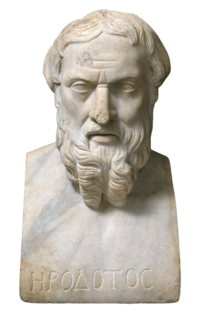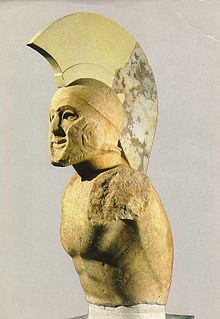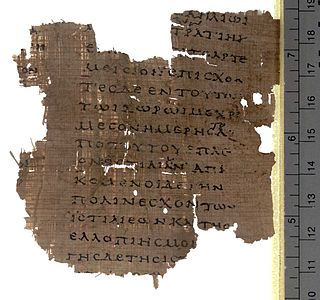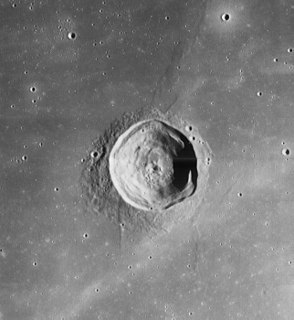
The Battle of Marathon took place in 490 BC during the first Persian invasion of Greece. It was fought between the citizens of Athens, aided by Plataea, and a Persian force commanded by Datis and Artaphernes. The battle was the culmination of the first attempt by Persia, under King Darius I, to subjugate Greece. The Greek army inflicted a crushing defeat on the more numerous Persians, marking a turning point in the Greco-Persian Wars.

Herodotus was an ancient Greek writer, geographer and historian born in the Greek city of Halicarnassus, part of the Persian Empire. He is known for having written the Histories – a detailed account of the Greco-Persian Wars. Herodotus was the first writer to do systematic investigation of historical events. He is referred to as "The Father of History", a title conferred on him by the ancient Roman orator Cicero.

The Battle of Salamis was a naval battle fought between an alliance of Greek city-states under Themistocles, and the Persian Empire under King Xerxes in 480 BC. It resulted in a decisive victory for the outnumbered Greeks. The battle was fought in the straits between the mainland and Salamis, an island in the Saronic Gulf near Athens, and marked the high point of the second Persian invasion of Greece.

Leonidas I was a king of the Greek city-state of Sparta, and the 17th of the Agiad line, a dynasty which claimed descent from the mythological demigod Heracles and Cadmus. Leonidas I was son of King Anaxandridas II. He succeeded his half-brother King Cleomenes I to the throne in c. 489 BC. His co-ruler was King Leotychidas. He was succeeded by his son, King Pleistarchus.

The Battle of Thermopylae was fought between an alliance of Ancient Greek city-states, led by King Leonidas I of Sparta, and the Achaemenid Empire of Xerxes I. It was fought over the course of three days, during the second Persian invasion of Greece.

A transient lunar phenomenon (TLP) or lunar transient phenomenon (LTP) is a short-lived light, color or change in appearance on the surface of the Moon. The term was created by Patrick Moore in his co-authorship of NASA Technical Report R-277 Chronological Catalog of Reported Lunar Events, published in 1968.

The Greco-Persian Wars were a series of conflicts between the Achaemenid Empire and Greek city-states that started in 499 BC and lasted until 449 BC. The collision between the fractious political world of the Greeks and the enormous empire of the Persians began when Cyrus the Great conquered the Greek-inhabited region of Ionia in 547 BC. Struggling to control the independent-minded cities of Ionia, the Persians appointed tyrants to rule each of them. This would prove to be the source of much trouble for the Greeks and Persians alike.

The Battle of Plataea was the final land battle during the second Persian invasion of Greece. It took place in 479 BC near the city of Plataea in Boeotia, and was fought between an alliance of the Greek city-states, and the Persian Empire of Xerxes I.

Aristarchus is a lunar impact crater that lies in the northwest part of the Moon's near side. It is considered the brightest of the large formations on the lunar surface, with an albedo nearly double that of most lunar features. The feature is bright enough to be visible to the naked eye, and displays unusually bright features when viewed through a large telescope. It is also readily identified when most of the lunar surface is illuminated by earthshine. The crater is deeper than the Grand Canyon.

The Histories of Herodotus is considered the founding work of history in Western literature. Written in 430 BCE in the Ionic dialect of classical Greek, The Histories serves as a record of the ancient traditions, politics, geography, and clashes of various cultures that were known in Greece, Western Asia and Northern Africa at that time. Although not a fully impartial record, it remains one of the West's most important sources regarding these affairs. Moreover, it established the genre and study of history in the Western world.

Herodotus is a lunar impact crater located on a low shelf in the midst of the Oceanus Procellarum. To the east is the slightly larger crater Aristarchus. West across the mare is Schiaparelli. Almost due south on the mare surface is a solitary lunar dome designated Herodotus Omega (ω).

Väisälä is a tiny lunar impact crater located on a rise in the Oceanus Procellarum. Sharing the same continental island are the brilliant crater Aristarchus to the south-southeast and Herodotus to the south-southwest. Väisälä lies just to the west of the Rupes Toscanelli fault line, and the Rimae Aristarchus rille system. To the southwest is the notable Vallis Schröteri cleft.

Schiaparelli is a lunar impact crater located on the western part of the Oceanus Procellarum, to the west of the crater Herodotus. The rim is relatively sharp-edged and relatively free from impact wear. The inner walls have slumped to form a shelf around much of the sides. The interior floor is somewhat irregular, but free from impacts of note.

Freud is a tiny lunar impact crater that lies on a plateau within the Oceanus Procellarum, in the northwest part of the Moon's near side. It is located a few kilometers to the west of the Vallis Schröteri, a large, sinuous valley that begins to the north of the crater Herodotus, then meanders north, then northwest, and finally southwest, until it reaches the edge of the lunar mare.

Raman is a small lunar impact crater that lies on the western edge of a plateau feature in the expansive lunar mare named Oceanus Procellarum. It shares this plateau with the lava-flooded Herodotus and Aristarchus to the southeastern. To the northeast of Raman is the small peak named Mons Herodotus. To the northwest on the mare is the long, narrow range named the Montes Agricola.

Schroter's Valley, frequently known by the Latinized name Vallis Schröteri, is a sinuous valley or rille on the surface of the near side of the Moon. It is located on a rise of continental ground, sometimes called the Aristarchus plateau, that is surrounded by the Oceanus Procellarum to the south and west and the Mare Imbrium to the northwest. At the southern edge of this rise are the craters Aristarchus and Herodotus.

Montes Agricola is an elongated range of mountains near the eastern edge of the central Oceanus Procellarum lunar mare. It lies just to the northwest of a plateau containing the craters Herodotus and Aristarchus.

The eclipse of Thales was a solar eclipse that was, according to The Histories of Herodotus, accurately predicted by the Greek philosopher Thales of Miletus. If Herodotus's account is accurate, this eclipse is the earliest recorded as being known in advance of its occurrence. Many historians believe that the predicted eclipse was the solar eclipse of 28 May 585 BC. How exactly Thales predicted the eclipse remains uncertain; some scholars assert the eclipse was never predicted at all. Others have argued for different dates, but only the eclipse of 28 May 585 BC matches the conditions of visibility necessary to explain the historical event.

The Achaemenid Empire, also called the First Persian Empire, was an ancient Iranian empire that was based in Western Asia and founded by Cyrus the Great. It reached its greatest extent under Xerxes I, who conquered most of northern and central ancient Greece, including the city of Athens, in 480 BC. At its greatest territorial extent, the Achaemenid Empire stretched from the Balkans and Eastern Europe in the west to the Indus Valley in the east. The empire was larger than any previous empire in history, spanning a total of 5.5 million square kilometers.
The Noumenia is the first day of the lunar month and also a religious observance in ancient Athens and much of Greece.




















